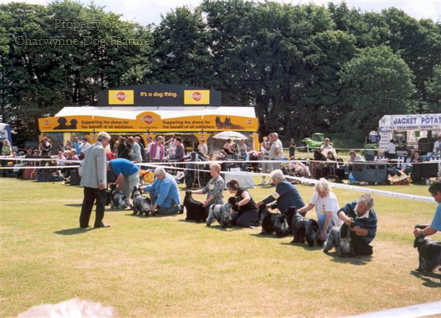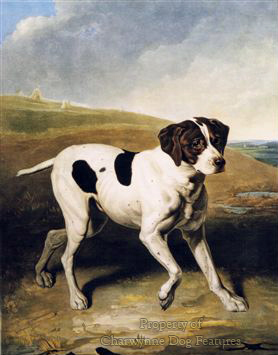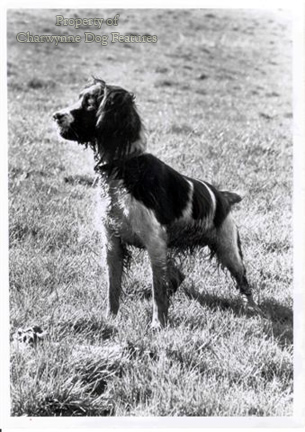321 Sporting Dogs in Fashion
SPORTING DOGS IN FASHION
by David Hancock
 The 20th century, both in the show ring and in the field, saw huge swings in the popularity of so many breeds of dog. In the latter half of the last century, the world of pure-bred dogs could be summarised by two dominant features: the extraordinary increase in foreign breeds becoming recognised and favoured here and the remarkable popularity of German breeds in the United Kingdom. One sad aspect of these changes however has been the threat to some of our native breeds, some of which could be lost to us in this century. The most popular breed in 1908 was the fox terrier, with 1,800 smooths and 1,400 wire-haired dogs being registered. In 1999, only 170 smooths and 600 wire-haired fox terriers were registered. The most popular breed in 1947 was the Cocker Spaniel. In 1999 the Cocker came fourth, yet with twice the number of dogs registered over the 1947 figure.
The 20th century, both in the show ring and in the field, saw huge swings in the popularity of so many breeds of dog. In the latter half of the last century, the world of pure-bred dogs could be summarised by two dominant features: the extraordinary increase in foreign breeds becoming recognised and favoured here and the remarkable popularity of German breeds in the United Kingdom. One sad aspect of these changes however has been the threat to some of our native breeds, some of which could be lost to us in this century. The most popular breed in 1908 was the fox terrier, with 1,800 smooths and 1,400 wire-haired dogs being registered. In 1999, only 170 smooths and 600 wire-haired fox terriers were registered. The most popular breed in 1947 was the Cocker Spaniel. In 1999 the Cocker came fourth, yet with twice the number of dogs registered over the 1947 figure.
Thirty years ago, breeds like the Afghan Hound, (2,800 registered in 1970, 259 in 1999) and the Beagle (3,900 registered in 1969, 991 in 1999) were much more popular. The rise of the German breeds, even in thirty years has been astonishing; 16,000 German shepherd dogs were registered in 1970, 25,690 in 1996 but not one was listed in 1910. 164 Rottweilers were registered in 1970, 10,341 in 1989. 187 Weimaraners were registered in 1969, 2,743 in 1998.
In 1999, the Kennel Club newly registered well over 1,000 German short-haired pointers against 800 of our own; over 500 American Cocker Spaniels against 89 Sussex Spaniels and more Brittanies than either Field or Clumber Spaniels. Shakespeare may have written that our mastiffs 'are of unmatchable courage' but the public prefer a German mastiff, the Great Dane, with over 2,000 of the latter registered each year, against around 500 of our native breed. In the light of this, you could be forgiven for thinking that we are doing a great deal to popularise foreign breeds and very little to promote our own native breeds. There is a measurable threat to a number of our world-renowned British breeds which could lead in time to their disappearance. 
Even fifty years ago, gundog fanciers preferred British dogs; not now. Each year an additional three and a half thousand pointers from Germany increase the German representation, to outnumber the combined annual registrations of all the setter breeds and the pointer of these islands. More Italian spinones and Hungarian vizslas are registered annually than four of our spaniel breeds. The preference for 'hunt, point and retrieve' breeds has largely caused this, but if our ancestors had needed an allrounder, they would have bred one themselves -- and it would have become world famous. Have our sportsmen lost their breeding skills as well as their patronage of age-old British breeds? The Kennel Club finds no role for itself in promoting our native breeds.
The success story of the 20th century is undoubtedly that of the Labrador retriever, with the golden retriever and the English springer not far behind. In his 'Dogs since 1900', Arthur Croxton Smith wrote: "The year 1903 was memorable in the history of Labradors, which had hitherto been little known except among a few select sporting families...I must admit that before 1903 I had never seen one...Then in that year a class was provided for them at the Kennel Club show at the Crystal Palace." In 1908, 123 were registered, in 1912 - 281, in 1922 - 916, by the 1950s 4,000 were being registered each year, in the 1980s - 15,000 a year, rising to nearly 36,000 in 1998. No other breed in the history of pure-bred dogs can match that rise in popularity.
The Kennel Club recognises 36 gundog breeds; 19 of these originated overseas. It recognises 33 breeds in the Hound Group; 26 came from outside the United Kingdom. Every year more breeds come on to the register, some of them from strange backgrounds. The Norwegian Lundehund, or puffin dog, is now listed in the Hound Group. This dog, which locates puffin nests, features "at least six toes on all four feet", comes from one remote area and has no history of being pure-bred. Foreign breeders rarely let their best stock go; without long breeding records, who knows what 'genetic junk' we are introducing?
Against that background it is disturbing to check the registrations of those of our native breeds, with extremely long breeding records, with fewer than 200 being bred each year: the curly-coated retriever; Clumber, field, Irish water and Sussex spaniels; Dandie Dinmont, Manchester, Norwich, Sealyham, Skye, English Toy (black and Tan) and miniature bull terriers; smooth collie, Otterhound, Bloodhound and Welsh corgi (Cardigan). Their names alone usually show how British they are.
As the Sealyham terrier fades (182 registered in 1989, only 58 in 1999) and the Dandie Dinmont terrier declines (256 in 1988, only 107 in 1999), we are importing the Cesky terrier, developed overseas from the Sealyham. As the field spaniel struggles to gain new owners (122 in 1989, against 75 in 1999), the Hungarian Vizsla goes from 223 in 1990 to over 600 in 1999. We lost our English water spaniel but now import both the Portuguese and the Spanish water dogs. Eight times as many Siberian huskies were registered here in 1999 than Skye terriers. Established native breeds such as the Patterdale, Plummer and Lucas Terriers are unrecognised. Is there a need to restrict the entirely whimsical and wholly unjustified fashion for importing fresh foreign breeds into this country?
Coming along behind the German short-haired pointers are the Stichelhaars and the Langhaars, behind the Large Munsterlander is the small variety and the physically similar Wachtelhund. Apart from 24 distinct hound breeds, from France could come their pointers: the Braque D'Auvergne, the Braque St.Germain and the two sizes of Braque Francais, and the Epagneuls: Picard, de Pont-Audemer and Francais. Our sporting breeds could suffer as we are swamped by breeds of which we know too little. 
The Federation Cynologique Internationale (FCI) or world kennel club, recognises 340 breeds, well over twice the number recognised by our KC and the American KC. But the FCI has at last acknowledged the need to restrict the number of new breeds it accepts. It now demands a minimum of eight distinct bloodlines, at least a thousand dogs registered and evidence of control of hereditary problems. Against those criteria, breeds like the Norwegian Lundehund would never be allowed in here. There is now a real need for more awareness of old British breeds. It would be good to see the admirable curly-coated retriever becoming more popular as a companion dog. The huge popularity of the Labrador has resulted in both over-breeding and unwise breeding leading to undesirable health problems in some stock, as it has in the golden retriever too.
Kennel Club registrations are currently falling; since 1996, when over 270,000 registrations were processed, the KC has lost a total of almost 50,000 in annual registrations. The gundog group still accounts for well over 80,000 of these registrations, easily the largest group. If the BFSS or BASC made themselves responsible for such registrations and maintained the same scale of costs, they would receive the best part of a million pounds. Quite a thought! Think of the health schemes which could be financed by such income.
Of course, owners of gundogs who are solely interested in showing their dogs at KC-licensed shows will still want to register their dogs with them. But most dogs registered are just pets. These, together with gundogs intended for work, would probably make up around 55% of gundogs registered. If these alone came over to a new scheme, they would still bring with them roughly £500,000 in revenue, a sum worth more than a passing thought. The fashion of registering sporting dogs with the KC should have gone 'out of fashion' a long time ago. Owners of sporting dogs have been slow to realise that the Kennel Club itself is slowly but surely going out of fashion.